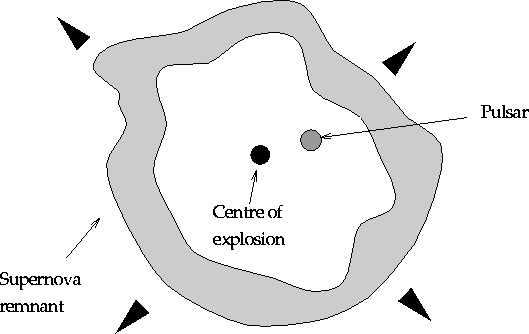
Bryan Gaensler and Simon Johnston have suggested that the observed distributions of pulsars and supernova remnants are consistent with one of each being formed by every supernova explosion. Although there are about 15 claimed associations between these objects, about half of these are probably coincidental rather than real.
A supernova explosion can leave behind two bits of evidence for its passing: a pulsar and a supernova remnant. A pulsar is a spinning neutron star, about 1.4 times as massive as the Sun but with a diameter of only 20 kilometers. Pulsars emit beams of radio waves that are detected as a series of pulses, in the same way as we see flashes from a rotating lighthouse beam. Supernova remnants are the expanding shells of hot gas produced as the energy of the supernova explosion is transferred to the material that surrounded the star before it exploded. They can be detected from radio to X-ray wavelengths and are usually characterized by a bright circular shell. Figure 2 shows a sketch of an association between a pulsar and a supernova remnant. Pulsars generally move away from the center of the supernova remnant with which they are associated, since they usually have quite high velocities.

Figure: A sketch of an association between a pulsar and a supernova remnant.
In the 1930s it was proposed that the very faint star at the center of the Crab Nebula is the remnant from the supernova explosion observed by Chinese astronomers in 1054 AD. It took more than 30 years for this idea to be confirmed through the discovery of pulsars and the identification of the source in the center of the Crab Nebula as a pulsar soon afterwards.
Although more than 25 years have elapsed since the discovery of the Crab pulsar in a supernova remnant it is still not clear what fraction of supernova explosions produces both shell-type supernova remnants and pulsars. Recent estimates range from 0 to 100 per cent! Part of the problem in identifying associations between observed pulsars and supernova remnants lies in distinguishing between what is a real association and what is merely a chance alignment on the sky. In this, as in other aspects of astronomy, we are constantly frustrated by our lack of knowledge of distances to objects. In particular, distances to supernova remnants are not known at all well.
Bryan Gaensler and Simon Johnston looked into this problem in some detail
during 1994.
They developed a simple model for the time-evolution
of the brightness and diameter of a shell remnant and then used it
in numerical simulations
of the Galactic population of shell supernova remnants and radio pulsars.
Bryan and Simon also developed models for the `selection effects' which
determine our ability to detect supernova remnants in real surveys.
These selection effects are severe, as indicated by the fact that
surveys have only discovered  supernova remnants out of the
many thousands thought to be present in the Galaxy.
Bryan and Simon also incorporated standard ideas about the evolution and detection of radio pulsars in the simulation.
By combining the synthetic distributions of shell remnants and pulsars
obtained from the Monte Carlo simulations with the models for
observational selection effects Bryan and Simon then simulated the
results of surveys to look for supernova remnants and pulsars.
The results of these simulated surveys were then compared
in order to identify what would be regarded as associations
between pulsars and supernova remnants.
A comparison of the results of the simulated surveys and the real
observational data provides important clues as to the reliability
of the claimed associations of real pulsars and supernova remnants.
Bryan and Simon developed a simple statistical test which
helps separate real pulsar/supernova remnant associations
from those that are geometric coincidences,
resulting from chance alignment.
They concluded that the observational
data are consistent with the possibility that all supernova explosions
produce both a shell-type remnant and a pulsar.
The results also suggest that many of the claimed associations
between supernova remnants and pulsars
are probably due to chance alignment and hence are spurious.
supernova remnants out of the
many thousands thought to be present in the Galaxy.
Bryan and Simon also incorporated standard ideas about the evolution and detection of radio pulsars in the simulation.
By combining the synthetic distributions of shell remnants and pulsars
obtained from the Monte Carlo simulations with the models for
observational selection effects Bryan and Simon then simulated the
results of surveys to look for supernova remnants and pulsars.
The results of these simulated surveys were then compared
in order to identify what would be regarded as associations
between pulsars and supernova remnants.
A comparison of the results of the simulated surveys and the real
observational data provides important clues as to the reliability
of the claimed associations of real pulsars and supernova remnants.
Bryan and Simon developed a simple statistical test which
helps separate real pulsar/supernova remnant associations
from those that are geometric coincidences,
resulting from chance alignment.
They concluded that the observational
data are consistent with the possibility that all supernova explosions
produce both a shell-type remnant and a pulsar.
The results also suggest that many of the claimed associations
between supernova remnants and pulsars
are probably due to chance alignment and hence are spurious.